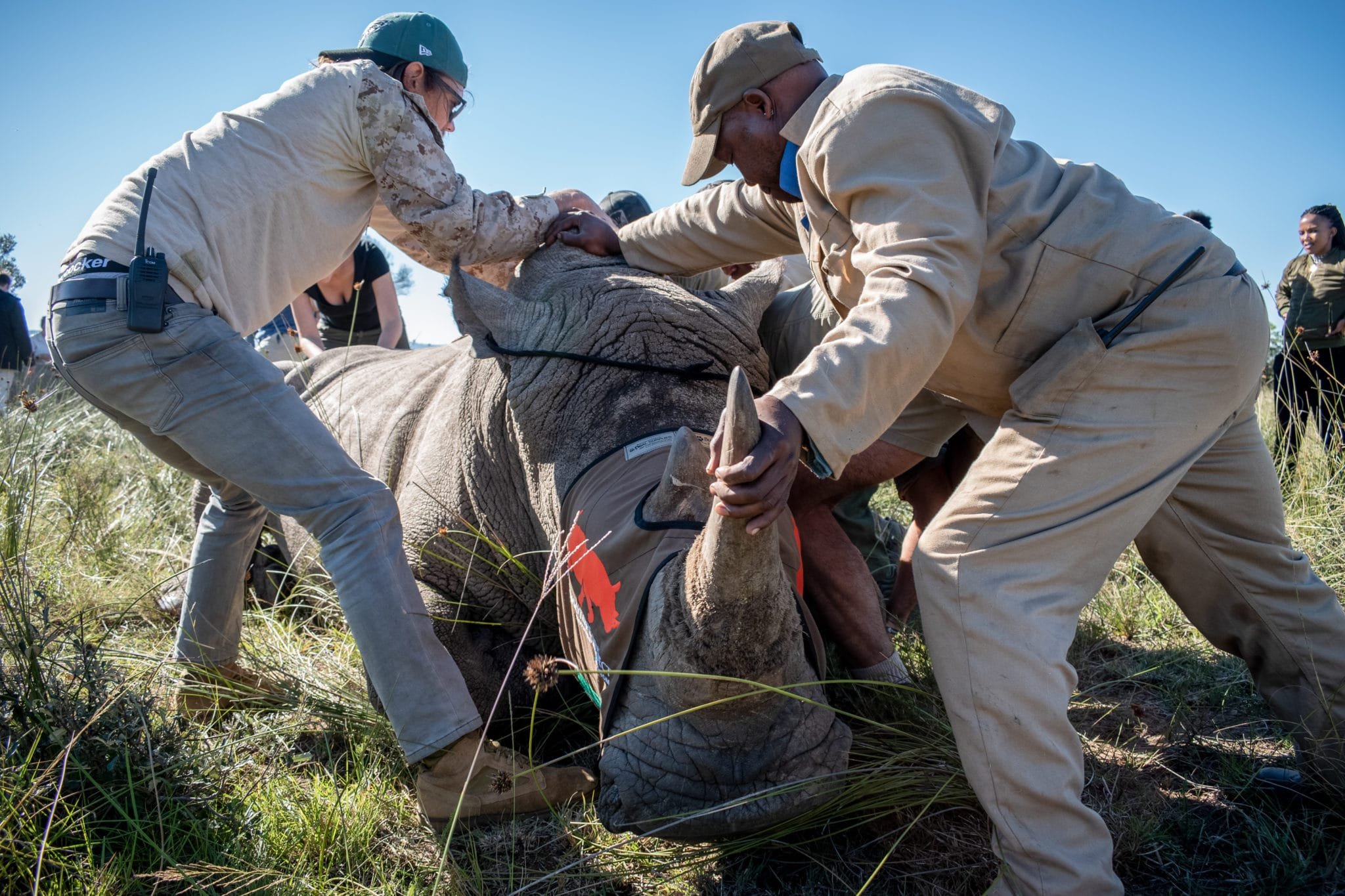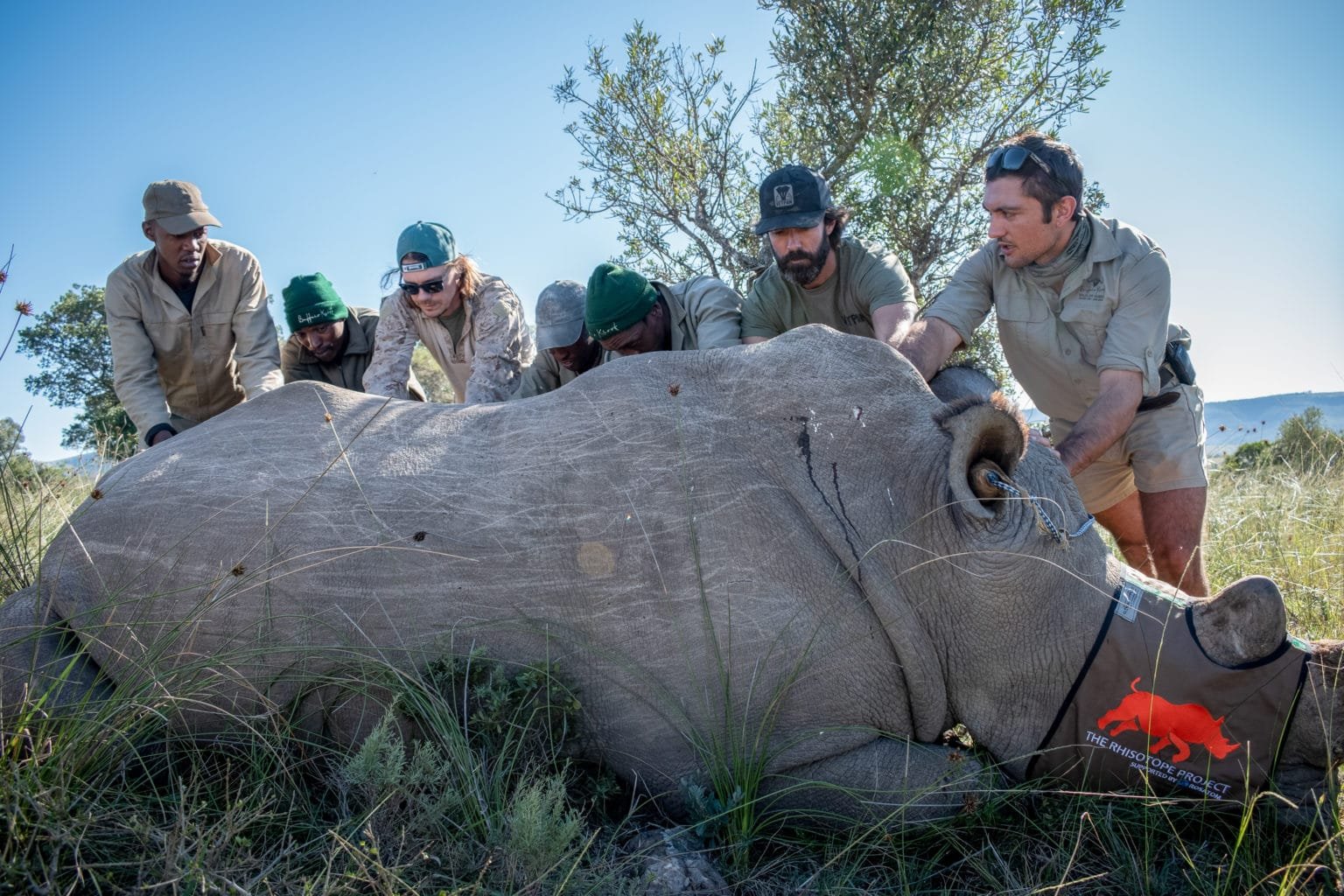Help us reduce the demand for rhino horn and track down traffickers
The Rhisotope Project is working on a new approach combining nuclear technology and environmental conservation.
Donate below to support the research of rhino protection by using radioactive isotopes as a poaching deterrent.
But what if we told you that nuclear science could save rhinos?
By inserting measured quantities of radioisotopes into the horns of live rhinos, The Rhisotope Project aims to use nuclear science for conservation. This is a non-lethal yet powerful solution that seeks to radically reduce the demand from end-users and save rhinos from the very real threat of extinction.
Making rhino horns radioactive reduces their desirability. Radioactively treated horns are more likely to be detected at international borders, making it more likely that smuggling syndicates will be exposed, prosecuted, and convicted under anti-terrorism laws.
In addition, the focus of the project is not only to protect rhinos and the environment, but also to support local communities. Through community educational efforts and ranger training programmes, we allow communities to reap the benefits of living rhinos. This means that instead of fueling wildlife crime, one of the four major black market crimes, people will want to protect the rhinos and environments that they live in. This creates a virtuous cycle: when people take care of the ecosystems around them, the ecosystems will in turn take care of them.
The Rhisotope Project was founded in 2021 by Prof. James Larkin, the radiation and health physics unit director at Wits University, and co-founder Suzanne Boswell. Using science-based solutions, the project hopes to curb the demand for rhino horns and save the species.
Watch the Rhisotope Introduction Video
The Rhisotope Project envisions a world where there is no demand or supply for rhino horns, so there is no market for it. Our goal is for the only value of rhino horns to be environmental.
Fusing Nuclear Science with Wildlife Protection
-
In the past, conservation efforts have mainly focused on guarding and protecting animals in their habitats. However, extensive long term anti-poaching activities and habitat protection resulted in a cat-and-mouse game with organised crime, which exhausts conservation resources.
Rhino horn is worth more than its weight in gold, and on the black market, it can be worth as much as 65,000$ per kilogram. Although the trade of rhino horn is illegal, the higher the value attributed to a product, the higher the incentive to bypass rules around trading it. For those on the front lines, protecting rhinos is a lot more than a conservation challenge.
In South Africa, the Kruger National Park staff stated that rhinos would likely be poached out of the park in only a few years if the current trend continues.
In recent years, the radical method of carefully dehorning rhinos while keeping them alive has been developed and applied in order to save as many rhinos as fast as possible. In theory, cutting off a rhino’s horns not too close to its roots is painless for the animal, and it will actually grow back again. In this way, a dehorned rhino in the wild is of no value to poachers. In South Africa, due to the fact that around 6,000 rhinos are in private hands, this activity led to the government allowing land owners to monetise their stock, meaning the domestic trade of rhino horn was legalised. The problem is that we then once again have a market flooded with products: a market with such a high demand and so lucrative, that it continues to attract all sorts of criminal activity.
This is why our goal is, instead, to remove the value projected onto something that is virtually useless for humanity.
-
Develop a cost-effective, safe, and user-friendly method to produce durable, detectable horn markers without harm to animals or the environment.
Licensed vets will acquire Rhisotope's radioisotopes, administering them into rhino horns. The five-year treatment cycle, with a radiation protection plan, involves a supplementary dose. Initial buyers include private rhino owners, expanding to park and reserve animal populations.
-
Deter poaching and end-user markets
The intention is to use the end-user's natural fear of radioactive materials to dissuade them from wishing to purchase or otherwise acquire radioactive horn.
Increase detection capabilities
There are more than 10 thousand radiation portal monitors (RPMs) installed at airports, harbours, and other ports of entry in over 50 countries. Thousands of trained personnel are routinely equipped with radiation detectors. This creates a powerful force multiplier against wildlife crime.
Increase prosecution success
Radioactively treated horns are more likely to be detected at international borders, making it more likely that smuggling syndicates will be exposed, prosecuted, and convicted under anti-terrorism laws.
Decrease corruption
Disrupting this illicit value chain would not only have a positive impact on the biodiversity of the affected areas but also put an end to the funding of other concurrent criminal activities and global corruption
Project Phases
Phase 1
In 2021, phase 1 was successfully implemented. It focused on the treatment of the horns of two white rhino bulls using stable compounds. The main objective of this six-month period was to demonstrate that there would be no transfer of the compound from the horn into the animals' bodies. Throughout the duration of the project, faecal and blood samples were collected from each rhino and subsequently analysed in a laboratory. The results obtained from the laboratory analysis provided conclusive evidence to support the initial hypothesis, confirming that there was no movement of the compound from the rhino horns into the animals' bodies.
Phase 2
This phase of the project is currently underway. It involves determining the radiological dose to the rhino's head, establishing the minimum detectable activity for accurate detection, and creating the Radiological Safety Assessment Report. The report is crucial for regulatory approval and submission to the Animal Research Ethics Committee.
Phase 3
Phase 3 of the project is the pilot phase, taking place in the Waterberg Region, South Africa, over six months. It involves applying radioisotopes to the horns of 20 rhinos at a secure facility. The metal alloy required for insertion is produced in a nuclear reactor. Samples are collected and analysed to confirm that the isotopes do not enter the animals' bodies.
Furthermore, this phase includes a philanthropic campaign to empower local communities and an educational programme. Veterinary surgeons are trained to ensure safe application of the radioisotopes, with discussions underway for certification through collaboration with universities.
Phase 4 & 5
The fourth and fifth phase entail the commercialisation of the procedure and expanding the research into other species and plants.
Unfortunately, the lack of funding means that the project is still standing.
You can help by donating directly to the project
-

Prof. James Larkin
James is Director of the Radiation and Health Physics Unit (RHPU) at the University of the Witwatersrand. He is also the Chairman of the university’s NIH mandated Institutional Biosafety Committee (IBC) and is a past chairman of the International Atomic Energy Agency (IAEA) International Nuclear Security Education Network (INSEN).
He is a Fellow of the Royal Society of Medicine, UK (FRSM), member of the Institute for Nuclear Materials Management, US (INMM), and a founding member of the Southern African Radiation Protection Association (SARPA). Visiting Researcher, King’s College, London.
He is heavily involved in international nuclear security education, and over the past ten years has been to numerous different countries to share his nuclear security knowledge and experiences with national, regional, and international audiences. At Witwatersrand University he teaches various courses in nuclear security, radiation protection, and nuclear facility leadership, and acts as the university’s radiation safety officer.
He was born and grew up in Kenya, where his love for wildlife started and continues today.
-

Dr. William Fowlds
William is a wildlife vet who dedicates his time to championing the plight of the rhino and other keystone species through his veterinary and awareness initiatives.
He started conveying the brutality of wildlife crime in 2011 when he was first called to the aid of a rhino butchered by poaching. Amongst others, his team documented a poaching attack on three rhinos at the Kariega game reserve in the Eastern Cape in March 2012. Two died and Dr Fowlds narrated the story of the slow rehabilitation of one of the three rhinos who survived this attack, as a means to raise awareness around anti-poaching and the illegal rhino horn trade. These emotional accounts have prompted media from around the world to convey the tragedy of the magnificent rhino.
Apart from his veterinary wildlife work he co-founded Investec Rhino Lifeline in 2013. He is the project coordinator for Wilderness Foundation Africa on the Medivet Saving the Rhino campaign which has enabled him to increase his work in rescue, education & awareness and prevention of poaching at both the protection and demand reduction sides of the crisis. He is a trustee of the Chipembere Rhino Foundation and the African Rhino Conservation Collaboration and strives to encourage a multi-faceted approach to the rhino crisis through increased collaboration and cohesion.
-

Jessica Babich
Jessica has a degree in Anthropology and is passionate about wildlife and people. Her speciality is environmental anthropology – which she is looking forward to bringing into The Rhisotope Project. As an independent sector consultant, her vision is to work with as many like-minded groups, organisations, people and projects as possible; uniting people to help them fight the crime and poaching scourge.
She has extensive knowledge and experience in project research, planning and implementation. She is skilled in working with all sector dynamics, from grassroots and local entities through to provincial, national and international collectives. By saving rhinos, she believes that people will be saved too.
Do you have any further questions? Visit the Rhisotope’s FAQ page or contact us via info@wildlifeforensic.com

Make an impact today
Your support helps protect rhinos from poaching by funding innovative science that uses radioactive isotopes as a deterrent. Every donation directly aids research, fieldwork, and conservation efforts. Thank you for making a difference!




